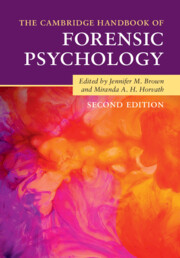Book contents
- The Cambridge Handbook of Forensic Psychology
- The Cambridge Handbook of Forensic Psychology
- Copyright page
- Dedication
- Contents
- Figures
- Tables
- Contributors
- Preface
- Forensic Psychology
- Part I Psychological Underpinnings
- 1.1 Cognitive Theories of Crime
- 1.2 Child and Adolescent Offending
- 1.3 Investigative Psychology
- 1.4 Neurological Theories
- 1.5 Personality
- 1.6 Theories of Sexual Offending
- 1.7 The Psychology of Violent Behavior
- 1.8 Investigative Decision-Making
- Part II Psychology and Criminal Behaviour
- Part III Assessment
- Part IV Interventions
- Part V Civil Proceedings
- Part VI Professional Practices
- Index
- References
1.6 - Theories of Sexual Offending
from Part I - Psychological Underpinnings
Published online by Cambridge University Press: 02 December 2021
- The Cambridge Handbook of Forensic Psychology
- The Cambridge Handbook of Forensic Psychology
- Copyright page
- Dedication
- Contents
- Figures
- Tables
- Contributors
- Preface
- Forensic Psychology
- Part I Psychological Underpinnings
- 1.1 Cognitive Theories of Crime
- 1.2 Child and Adolescent Offending
- 1.3 Investigative Psychology
- 1.4 Neurological Theories
- 1.5 Personality
- 1.6 Theories of Sexual Offending
- 1.7 The Psychology of Violent Behavior
- 1.8 Investigative Decision-Making
- Part II Psychology and Criminal Behaviour
- Part III Assessment
- Part IV Interventions
- Part V Civil Proceedings
- Part VI Professional Practices
- Index
- References
Summary
Sexual violence is an international public health issue, with high rates of victimisation found across countries, genders, ethnicities and deprivation levels. In this chapter we focus on the current predominant etiological theories of sexual offending, including child sexual abuse, adult sexual abuse, and internet offending. We begin by briefly discussing the importance of theories in forensic contexts, and providing an overview of the classification of sexual violence. We then introduce a framework for understanding different “levels” of etiological theory, before providing examples of some of the most influential theories of sexual offending corresponding to each of these levels. We finish by discussing the potential future of sexual offending theories, namely the current paradigm shifts that are occurring in terms of our understanding of risk and protective factors, and their relationship with sexual offending.
- Type
- Chapter
- Information
- The Cambridge Handbook of Forensic Psychology , pp. 109 - 127Publisher: Cambridge University PressPrint publication year: 2021
References
- 1
- Cited by

